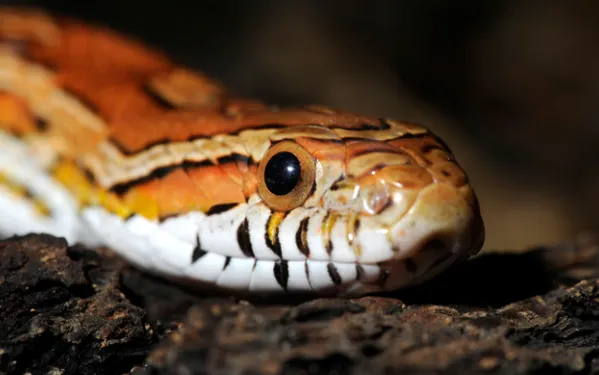
Table of Contents
Scientific Classification
- Kingdom: Animalia
- Phylum: Chordata
- Class: Reptilia
- Order: Squamata
- Family: Colubridae
- Genus: Pantherophis
- Species: Pantherophis guttatus
Quick Overview
The Corn Snake (Pantherophis guttatus) is a beloved and non-venomous snake indigenous to the southeastern United States. Known for its striking appearance, gentle nature, and ease of care, it’s a popular choice among reptile enthusiasts and novice snake keepers.
Fast Facts
- Scientific Name: Pantherophis guttatus
- Lifespan: 15-20 years in captivity, with some individuals exceeding this.
- Average Size: Typically 3-5 feet in length.
- Diet: Carnivorous, primarily feeding on rodents.
- Habitat: Versatile, from forests to grasslands and abandoned buildings.
Did you know?
The name “Corn Snake” may originate from its checkered belly scales, which resemble kernels of corn.
Appearance
Corn Snakes display a vibrant and distinct appearance with large, red-orange blotches outlined in black along their back. Background colors can vary from red to orange or brown, while their belly features black and white checkered scales.
Size and Weight
Typically, Corn Snakes reach a length of 3-5 feet and weigh between 300-900 grams. Females are generally larger than males.
Temperament and Behavior
Known for their gentle disposition, Corn Snakes are often the first choice for novice snake owners. They rarely bite and tolerate handling well. These snakes are primarily active during the evening and night.
Fun Fact
Corn Snakes have an incredible sense of taste and smell, allowing them to explore and interact with their environment in a unique and fascinating way.
Habitat and Distribution
Corn Snakes are indigenous to the southeastern United States, spanning regions from New Jersey to the Florida Keys and as far west as Louisiana. They are adaptable and can thrive in various habitats, including forests, grasslands, and even abandoned structures.
Care Guide
For prospective Corn Snake owners:
- Habitat: Provide a secure and escape-proof enclosure with hiding spots and climbing opportunities.
- Temperature: Maintain a temperature gradient within the enclosure, with a warm side of 85-90°F (29-32°C) and a cool side of 75-80°F (24-27°C).
- Humidity: Keep the humidity level between 30-50% to replicate their natural environment.
- Diet: Feed your Corn Snake appropriately-sized prey, such as mice or rat pups, every 5-7 days.
- Health Check-ups: Schedule regular check-ups with a reptile veterinarian and minimize excessive handling to reduce stress.
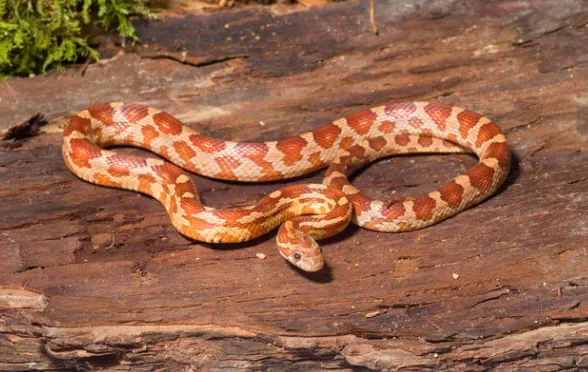
Diet and Nutrition
As carnivorous reptiles, Corn Snakes primarily prey on rodents, such as mice and small rats. In captivity, they are often fed appropriately-sized frozen-thawed rodents.
Health and Wellness
Providing a suitable habitat, proper temperature and humidity, and regular check-ups with a reptile veterinarian are essential to ensure the health of your Corn Snake.
Breeding
Corn Snakes are among the most commonly bred snakes in the pet trade. Breeding typically occurs in the spring, with clutches of eggs laid and then incubated for approximately two months.
Conservation Status
Corn Snakes are not considered endangered, but their populations may face threats from habitat destruction. Conservation efforts aim to protect their natural habitats.
Photo Gallery
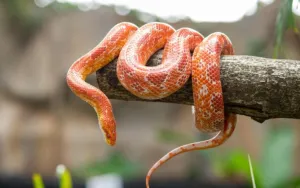
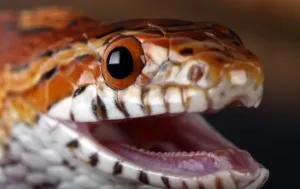
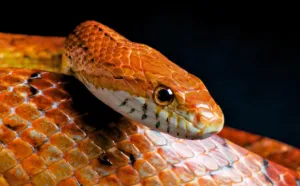
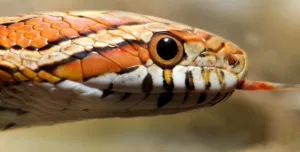
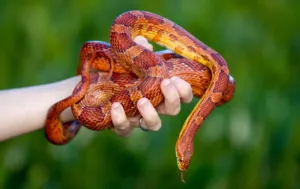
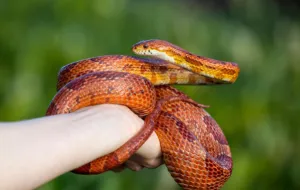
Check out the video below of a Corn Snake bluff strike:
Share This Profile:
3 Amazing Facts About Corn Snake
- Color Variability: Corn Snakes exhibit an astonishing array of colors and patterns in captivity, from classic “wild type” to various designer morphs, making them a favorite among snake enthusiasts.
- Escape Artists: They are skilled climbers and adept at escaping enclosures. Secure tanks with tight-fitting lids are essential.
- Docile Nature: Corn Snakes are known for their calm and non-aggressive behavior, making them a popular choice for beginner snake owners and collectors alike.
- Enchi Ball Python: A Unique and Stunning Morph of Python regius - March 27, 2025
- Emerald Tree Monitor: The Enigmatic Green Guardian of the Rainforest - March 26, 2025
- The Egyptian Cobra (Naja haje): A Fascinating Serpent - March 25, 2025
